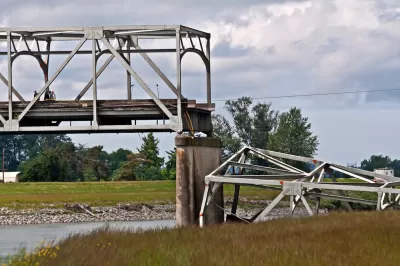Failing infrastructure is a life and death matter. Decaying roads, bridges, dam, pipelines, water delivery, and railroads lacking safety controls are responsible for the loss of thousands of lives annually, on top of illnesses and injuries.

"From coast to coast, the country’s once-envied collection of bridges, dams, pipelines, sewage treatment plants and levees is crumbling," writes Ron Nixon for The New York Times. "Studies have shown that a lack of investment in public infrastructure costs billions of dollars a year in lost productivity, as people sit in traffic or wait for delayed shipments."
However, costs go far beyond congestion. Public health, safety, and life itself are at stake. "Every year, hundreds of deaths, illnesses and injuries can be attributed to the failure of bridges, dams, roads and other decaying structures," writes Nixon.
The federal Department of Transportation (DOT) estimates that obsolete road designs and poor road conditions are a factor in about 14,000 highway deaths each year. Research by Ted Miller, a senior research scientist at the Pacific Institute for Research and Evaluation, which receives financing from the Transportation Department, put the medical cost of highway injuries from poor road conditions at $11.4 billion for 2013, according to the latest data available.
Nixon also writes about the loss of life due to other infrastructure failures including the lack of Positive Train Control for railroads, natural gas pipeline explosions, recent dam failures, disease outbreaks from "aging and crumbling water systems."
Much of America’s infrastructure was built many decades ago with the understanding that the structures would remain in place for no more than 50 years or so. But many structures have exceeded that age.
The six-year STRR Act that passed the House on Nov. 5 and the six-year DRIVE Act that passed the Senate on July 30 only keep transportation spending at current levels, adjusted for inflation, falling "far short of what many infrastructure experts say is needed, both in terms of time and money," notes Nixon.
“There is no question that there are safety impacts and loss of life because we didn’t take the time or spend the money to make infrastructure what it should be,” Anthony R. Foxx, the transportation secretary, said in an interview.
Joan Lowy of The Associated Press writes that Secretary Foxx indicated that a minimum of $400 billion over six years is needed. The STRR Act authorizes $325 billion, notes Lowy, though only has funds for the first three of the six years.
"President Obama, in his budget, had called for a larger, $478 billion program," writes
FULL STORY: Human Cost Rises as Old Bridges, Dams and Roads Go Unrepaired

Maui's Vacation Rental Debate Turns Ugly
Verbal attacks, misinformation campaigns and fistfights plague a high-stakes debate to convert thousands of vacation rentals into long-term housing.

Planetizen Federal Action Tracker
A weekly monitor of how Trump’s orders and actions are impacting planners and planning in America.

In Urban Planning, AI Prompting Could be the New Design Thinking
Creativity has long been key to great urban design. What if we see AI as our new creative partner?

King County Supportive Housing Program Offers Hope for Unhoused Residents
The county is taking a ‘Housing First’ approach that prioritizes getting people into housing, then offering wraparound supportive services.

Researchers Use AI to Get Clearer Picture of US Housing
Analysts are using artificial intelligence to supercharge their research by allowing them to comb through data faster. Though these AI tools can be error prone, they save time and housing researchers are optimistic about the future.

Making Shared Micromobility More Inclusive
Cities and shared mobility system operators can do more to include people with disabilities in planning and operations, per a new report.
Urban Design for Planners 1: Software Tools
This six-course series explores essential urban design concepts using open source software and equips planners with the tools they need to participate fully in the urban design process.
Planning for Universal Design
Learn the tools for implementing Universal Design in planning regulations.
planning NEXT
Appalachian Highlands Housing Partners
Mpact (founded as Rail~Volution)
City of Camden Redevelopment Agency
City of Astoria
City of Portland
City of Laramie


























